I want to connect my SQLite database/ or I think I'm connecting my "data.sqlite" (the blue highligted one in the picture below) with my views.py in the core folder (picture below) with:
rPath='../../Upchanges/data.sqlite'
conn = _sqlite3.connect(rPath, check_same_thread=False)
c = conn.cursor()
Path of the database I want to connect with: Upchanges_desperate/Upchanges/data.sqlite
Path of the Python file I want to connect with the database: Upchanges_desperate/Upchanges/core/views.py
Picture of my file orientation:
So this is my problem: I later use these codes below in my python file:
from Upchanges.models import BlogPost( I set the __tablename__ to 'blog_post' in another python file)
@core.route('/', methods=['GET', 'POST'])
def index():
search = Blogsearch_form(request.form)
if request.method == 'POST':
c.execute("SELECT * FROM blog_post WHERE problem_name LIKE(?)", ('%' + str(search) + '%',))
results = c.fetchall()
print(results)
return render_template('blog_search_result.html', results=results)
page = request.args.get('page',1,type=int)
many_posts = BlogPost.query.order_by(BlogPost.date.desc()).paginate(page=page, per_page=10)
return render_template('index.html', many_posts=many_posts, form=search)
When I input something and click enter in the Blogsearch_form, my website shows this error: "sqlite3.OperationalError: no such table: blog_post". I also tried replacing blog_post with BlogPost but it shows the same error: "sqlite3.OperationalError: no such table: BlogPost"
I promise you I have a blog_post table in my data.sqlite database. I use it also in some codes below and my website query the data and work just fine (show everything later on in the HTML file):
page = request.args.get('page',1,type=int)
many_posts = BlogPost.query.order_by(BlogPost.date.desc()).paginate(page=page, per_page=10)
return render_template('index.html', many_posts=many_posts, form=search)
Addtionally, for more clarity, these codes below (which is in the init.py of my app.py file) are those that create my data.sqlite database:
app.config['SQLALCHEMY_DATABASE_URI'] = 'sqlite:///' + os.path.join(basedir,
'../Upchanges/data.sqlite')
So, I really think that something is wrong with the path in the _sqlite3.connect command. I would greatly appreciate if you could help me fix the problem above. (Please use the picture when you think about the path as it is easier to imagine)
Thank you!!
P.s/ I tried this from my previous question: https://stackoverflow.com/a/61849867/13097721 but I still couldn't fix this problem.
